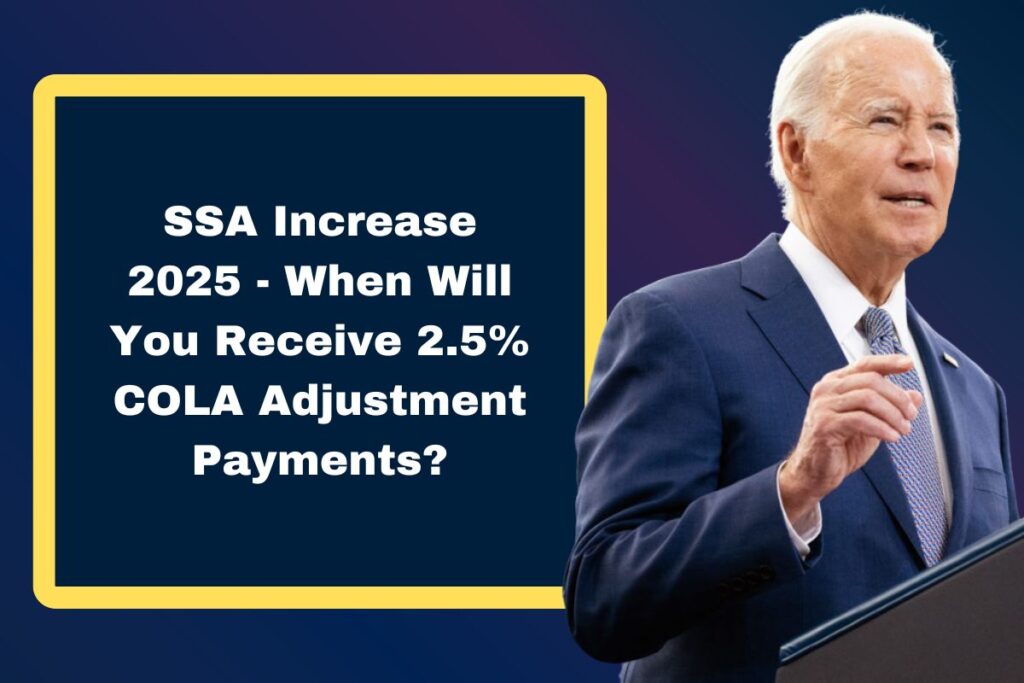Last month, the new cost-of-living adjustment (COLA) figure was released on October 10. So to determine the percentage increase in Social Security benefits for the upcoming year, SSA announces COLA each year. The new COLA statistic for 2025 may have some beneficiaries feeling taken aback or uneasy because it is lower than it has been in the previous four years. Monthly Social Security benefits are adjusted annually by the SSA to reflect general inflation.
When the organization announces the autumn rate increases that will take effect in January of the following year, it makes this adjustment in the third quarter. In September, inflation fell to 2.4%, but the SSA plans to raise benefits by 2.5% in 2025. A retiree will receive $102.50 in 2025 for every $100 they got in 2024, for instance. So check more news on SSA Increase 2025 Payment Date on this page.
SSA Increase 2025
A 2.5% rise in Social Security benefits is planned for 2025 and now people are waiting for SSA 2.5% COLA Adjustment Payments Date 2025. This announcement includes the latest update on 3rd quarter of last year’s CPI-W. For mostly blue-collar wage workers, the CPI-W is an index of the price of a basket of market items. The CPI-W is calculated using the average prices of over 200 items, including housing, transportation, food, drinks, and other necessities for the home.
The CPI-W tells COLA how much money should be added to payments to help beneficiaries keep up with growing expenses by looking at trends in price increases for specific goods. Many beneficiaries may be concerned about the new COLA data because it is the lowest since before the COVID-19 pandemic, especially in light of the present cost of living issue. While payments increased by 8.2% last year, COLA was fixed at 3.2% this year.
When Will You Receive 2.5% COLA Adjustment Payments?
A 2.5% COLA will be applied to over 68 million Social Security recipients starting in January 2025. Most of beneficiaries live entirely on their Social Security and frequently SSI income, even though the program’s goal is to supplement retirement income. If you are a social security beneficiary who is having trouble making ends meet, there are several government programs that can help you get care, including food aid, housing assistance, utility assistance, and healthcare support.
The people who depend on this financial assistance greatly benefit from this adjustment, which is called a COLA. The 2025 COLA increase was recently confirmed by the Social Security Administration (SSA), which has beneficiaries anticipating more. The way benefits are disbursed throughout the year is also affected by this change, in addition to monthly payments.

How to apply for Social Security COLA?
- Current Social Security recipients do not need to take any more action to take advantage of the 2025 COLA boost. For everyone who is already enrolled in the program, the Social Security Administration immediately modifies payments. There is no need for recipients to apply; the adjustments will start to appear in payments in January 2025.
- But people who aren’t receiving Social Security currently and intend to retire in the coming years should be mindful of how the COLA can affect their future benefits. If you want to apply, visit your area’s Social Security office or browse ssa.gov to apply online.
- Although the COLA is applied automatically, keep in mind that any changes to Social Security payments might have a big impact on your monthly budget, so it’s always beneficial to be informed.
Lower increases are not to be a cause of stress
A lower COLA is really preferred, despite the fact that it may seem illogical to want a smaller annual increase in payments. Since the CPI-W is used to calculate COLA, rising living expenses translate into a higher COLA. A lower COLA, however, indicates that inflation is decreasing and that growing product prices are leveling out. The cost of living is therefore not rising as much, hence a higher payment increase is not required. On average, COLA increases by roughly 2% annually.
The fact that COLA is currently more in line with average trends than it has been since the outbreak suggests that the economy may be stabilizing at last. The cost of living has skyrocketed over the last four years, and low- and middle-income households have been most affected. Although a lower COLA indicates a lesser gain, it does show that prices are approaching a level that is familiar.
Good news for recipients, but payments are still not enough
- Even if the economy is starting to stabilize, most of Social Security recipients looking for more government benefits. Although Social Security is meant to be a supplement to income, for most of recipients, it serves as their sole source of income. The payments that beneficiaries receive, even when the cost of living may be stable, are sometimes insufficient to cover all monthly household expenses, especially if beneficiaries have dependents.
- Furthermore, some have suggested that because most of recipients are not wage workers, COLA’s reliance on the CPI-W has a negative impact on beneficiaries. As a result, they spend differently from the population that the CPI-W monitors.
- As a result, changes in the goods that Social Security recipients do purchase are often not adequately reflected in the COLA figure, which prevents beneficiaries from receiving an increase in benefits that would adequately cover their pertinent monthly expenses.
- The first payment of the new COLA payments is scheduled to be issued in January 2025. Beneficiaries should be aware that increases in their payments will vary from person to person because Social Security is not a set amount, meaning that no two people get exactly the same amount.
| Our Homepage | Click Here |

